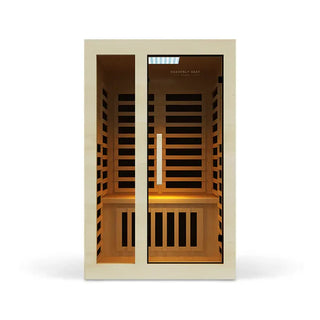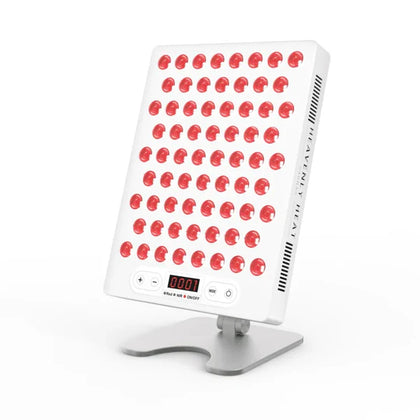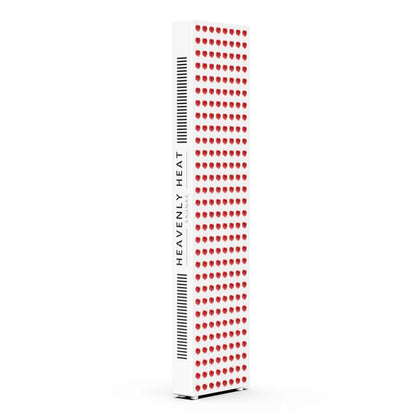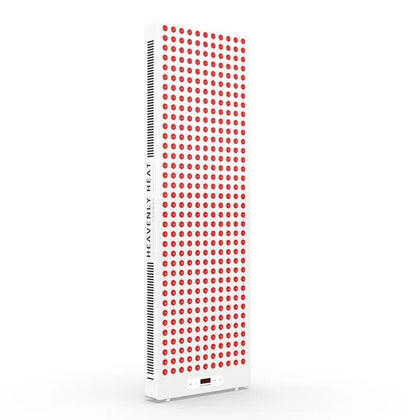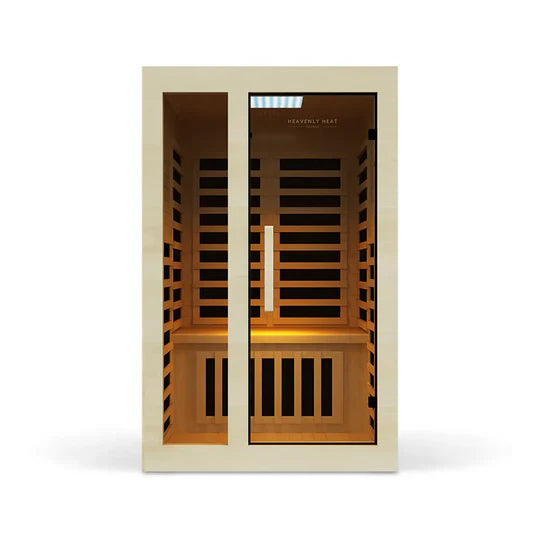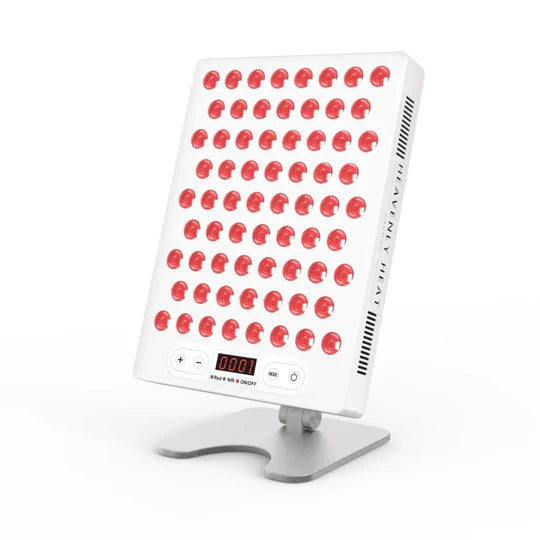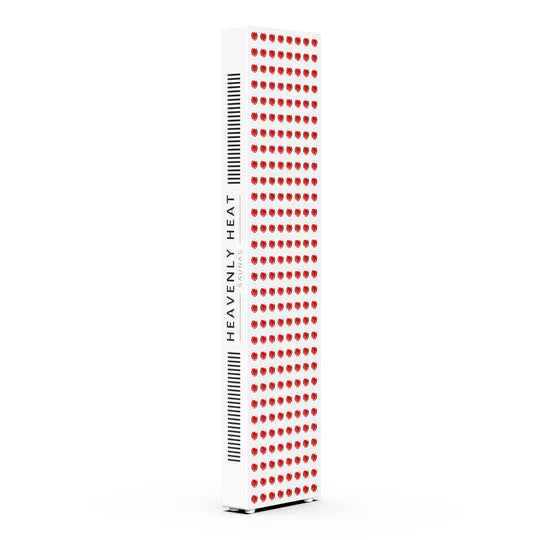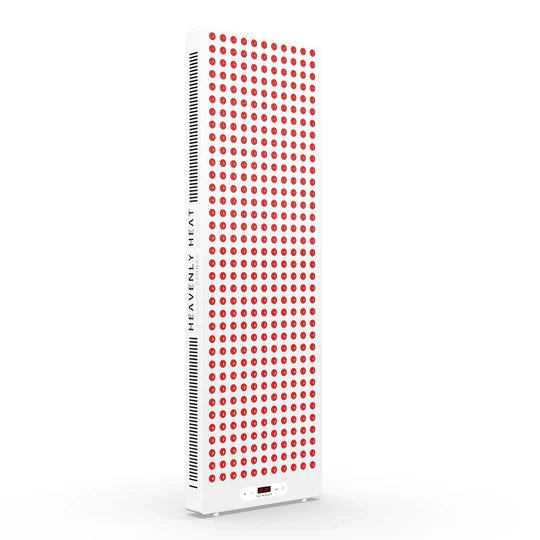How Deep Does Red Light Therapy Penetrate?

Red light therapy is more than just a beauty trend, it goes deep to help your skin, muscles, and joints heal.
But how deep does it really go? In this guide, you’ll learn how different devices work, what affects light penetration, and which types of light deliver the best results for real healing.
Table of contents
Key Takeaways
Red light therapy penetrates differently based on the wavelength: 660nm for surface-level issues, 850nm for deeper tissue healing.
Full-body panels penetrate deeper than handheld devices due to higher intensity and broader coverage.
Red light therapy is effective for pain relief, muscle recovery, and skin rejuvenation by stimulating circulation and cellular regeneration.
Factors like angle, pressure, and temperature can influence how deeply red light penetrates the skin.
Clinical devices generally offer deeper penetration than home-use models due to their higher power output.
Types of Red Light Therapy Devices
Handheld Devices for Targeted Spot Treatments and Convenient Home Use
- Target Specific Areas for Effective Spot Treatments: Handheld red light therapy devices are designed to focus on particular areas, such as sore muscles or skin imperfections. These portable devices help reduce inflammation and promote healing through red or near-infrared light.
- Convenient at-Home Use for Skin and Healing Benefits: These devices are perfect for at-home therapy, allowing users to improve skin health, reduce fine lines, and heal sore muscles. Regular use leads to noticeable improvements in skin texture over 4 to 12 weeks.
- Customizable Settings for Personalized Treatment: With adjustable settings, users can tailor treatments based on their specific needs, ensuring effective therapy for targeted areas.
Full-Body Red Light Panels for Comprehensive, Time-Efficient Therapy Sessions
Full-body panels deliver red light therapy to your entire body at once, making them great for quick, effective treatments.
These devices cover a larger surface area, allowing for simultaneous treatment of multiple areas.
They are ideal for people seeking efficient therapy sessions with adjustable light intensity to suit personal preferences.
Red Light Therapy Masks for Facial Skin Care and Anti-Aging Benefits
Red light therapy masks focus on facial treatments, improving skin tone, reducing wrinkles, and stimulating collagen production.
These masks can enhance skin texture, combat aging signs, and help promote a more youthful, glowing complexion.
Wearable Red Light Therapy Products for Hands-Free Therapy on the Go
- Convenient Therapy on the Go: Wearable devices like wraps and straps provide a convenient way to get red light therapy without interrupting your daily activities.
- Comfortable and Discreet for Everyday Use: These devices are designed to be both comfortable and discreet, making it easy to wear them throughout your day without drawing attention.
- Support for Muscle Recovery and Wellness: Wearable red light therapy helps with muscle recovery and supports overall wellness, giving your body the care it needs while you’re on the go.
Red Light Therapy Beds and Booths for Full-Body Treatment in a Spa Setting
Red light therapy beds and booths provide full-body treatments in professional settings, offering deeper penetration and broader coverage.
These powerful devices can target multiple areas at once, promoting healing, skin rejuvenation, and pain relief through deep penetration of red and near-infrared light.
Red Light Therapy Devices for Targeting Joint Pain and Muscle Recovery
- Red light helps reduce joint pain by going deep into the body: Red light therapy reaches deep into your joints, helping reduce pain and swelling by improving blood flow and healing tissues from the inside.
- Muscle recovery becomes faster when red light is used regularly: Using red light therapy after workouts or physical strain helps relax muscles, ease soreness, and bring flexibility back quicker than usual.
- Different red light devices can treat pain in different ways: From small handheld tools to big panels or wearable devices, each one helps with joint pain and muscle recovery depending on where and how you use it.
Compact, Portable Red Light Devices for Travel and On-the-Go Therapy
- You can easily carry these devices while traveling: Portable red light therapy devices are made to be compact, lightweight, and easy to pack, so you can take them with you wherever you go, whether it’s for work or vacation.
- No need to stop your therapy while you’re on the move: These handy devices let you continue your red light therapy without needing large, bulky equipment. They are perfect for busy lifestyles and frequent travelers.
- Small size doesn’t mean less power: Even though these devices are small, they still help reduce pain, improve your skin, and support your overall wellness just like the bigger ones.

How Light Waves Interact with Skin Layers?
Red light therapy utilizes red and near-infrared light to penetrate the skin, reaching the epidermis and dermis layers.
Light energy is absorbed by skin cells, boosting ATP production, which helps cells repair and regenerate.
Longer wavelengths penetrate deeper, while shorter wavelengths target the skin's surface.
The absorbed energy stimulates various healing processes, such as collagen production and inflammation reduction.
Factors That Influence Penetration Depth
Material Hardness and Density
Harder and denser materials resist light penetration more than softer ones.
This means that tissues like thicker skin or muscles can reduce the effectiveness of therapy.
Darker skin absorbs more light at the surface, which can make it harder for the light to reach deeper layers.
Higher material density requires more energy for the light to penetrate effectively.
Impact Angle and Speed
The angle at which the light is applied impacts its penetration depth. A light source applied perpendicular to the skin will penetrate deeper compared to one at an angle.
The speed of light delivery also affects penetration, but it’s more crucial for soft tissues, with the right combination of angle and speed ensuring optimal therapy depth.
Temperature and Environment
Temperature can influence how deeply light penetrates. Warmer temperatures make tissues more pliable, allowing deeper penetration.
On the other hand, colder conditions can make tissues more rigid, reducing the depth of light penetration. Humidity and air pressure can also affect light absorption.
Shape and Type of Penetrator
The design and shape of the light source can determine how deeply it penetrates.
Focused light beams penetrate deeper, while diffused light reflects in all directions, with intensity affected by the angle of reflection.
Diffused light reaches broader areas but with less intensity. The size of the light’s tip and the velocity of delivery both influence the depth of penetration.
Surface Coatings or Treatments
Surface coatings can either enhance or hinder light penetration. Thicker coatings may reduce the therapy’s effectiveness, while porous or chemically treated surfaces can allow deeper light absorption, making treatments more effective.
Use of Lubricants or Fluids
Lubricants help reduce friction, allowing the light to glide smoothly across the skin and penetrate more effectively.
Lubricants with lower viscosity facilitate better absorption of light into tissues, enhancing the therapy’s depth and effectiveness.
Force Applied and Contact Time
The amount of pressure applied during treatment and the length of time the light is in contact with the skin can influence how deeply it penetrates.
Greater force and longer contact times allow the light to reach deeper layers, maximizing the therapy’s effectiveness.
Best Wavelengths for Deep Tissue Penetration
Near-infrared light (850 nm) is most effective for deep tissue penetration, reaching up to 5 cm into the skin.
This wavelength is ideal for muscle recovery, joint pain, and tissue healing. Red light (660 nm), on the other hand, is more effective for surface-level conditions like skin rejuvenation and minor wounds.
Handheld Devices vs. Full-Body Panels: Which Penetrates Deeper into the Skin?
- Full-body panels penetrate deeper into the skin: Full-body panels have a higher intensity and stronger power output, allowing them to reach deeper into the skin, making them ideal for treating larger areas.
- Handheld devices offer gentler treatments: Handheld devices are portable and convenient but have lower power levels. They focus on specific areas with a gentler treatment that doesn't penetrate as deeply.
Can Red Light Therapy Penetrate the Skull?
- Red Light Can Penetrate the Skull: Red light therapy can penetrate the skull, though it’s limited in how deep it can go.
- Skull Thickness Affects Light Penetration: The thickness of the skull can reduce how much light reaches deeper areas of the brain.
- Red Light Improves Blood Flow and Brain Function: Even with limited penetration, red light can improve blood circulation and help brain cells work better.
Clinical vs Home-Use red light therapy Devices: Which Penetrates Deeper into the Skin?
- Clinical Devices Offer Deeper Penetration Due to Higher Power Output: Clinical devices, used in diagnosis, treatment, and monitoring, are more powerful than home-use models. They offer deeper penetration because of their higher power output.
- Pulsed Therapy in Clinical Devices Helps Reach Deeper Skin Layers: These devices use rapid on/off cycles, minimizing heat buildup and allowing for higher peak power. This helps the light reach deeper into the skin effectively and safely.
- Clinical Devices Deliver Stronger Light for Better Therapeutic Results: Clinical devices deliver stronger light, enabling them to reach deeper tissues more effectively than most at-home devices. This results in better therapeutic outcomes.
- Home-Use Devices Lack the Wavelengths Needed for Deeper Treatments: Home-use models often lack the necessary therapeutic wavelengths (630–700nm), making them ineffective for deeper or more targeted treatments.
Comparison of Red Light vs. Other Types of Light Therapy in Terms of Penetration Depth
Red Light
Red light penetrates about 8-10 millimeters into the skin, making it effective for surface-level conditions like acne and wrinkles.
It works by stimulating blood circulation and cellular function, promoting healing and skin rejuvenation.
Near-Infrared Light
Near-infrared light penetrates deeper, up to 2–3 inches, and is more effective for deeper tissue healing, including muscles, joints, and bones. It helps alleviate pain, reduce inflammation, and promote muscle recovery.
Blue Light
- Blue light stays close to the skin’s surface: Blue light goes just 1–2 millimeters deep into the skin, so it can’t treat problems that lie deeper. It’s best for issues close to the surface, like acne.
- Blue light helps fight acne by killing bacteria and cutting oil: This light targets the bacteria that cause acne and reduces how much oil your skin makes. It focuses on oil glands to keep your pores clean and prevent new pimples.
Green Light
Green light is effective for treating skin pigmentation issues, such as dark spots and uneven skin tone.
It improves skin tone and reduces puffiness but has shallower penetration than red light.
It penetrates deeper than blue light but still remains a surface-level treatment.
Ultraviolet Light
Ultraviolet light can penetrate deeper than red light, reaching the dermis. While it can be beneficial for treating conditions like psoriasis, prolonged exposure to UV light can damage the skin and increase the risk of skin cancer.
Although people with lighter skin are more prone to UV damage, anyone, regardless of skin tone, can be affected by prolonged sun exposure.
Full-Spectrum Light
Full-spectrum light therapy combines various wavelengths, with red light targeting surface conditions and infrared light reaching deeper tissues.
This therapy provides a holistic approach for skin rejuvenation, muscle recovery, and inflammation reduction.
Comparison of 660nm vs 850nm red light therapy Wavelengths
Differences in Cellular Penetration: 660nm vs 850nm Light Therapy Wavelengths
660nm red light is ideal for surface-level conditions like skin rejuvenation, as it stimulates collagen production, helping form new cells and replace dead skin cells, which improves skin texture. It also aids in healing minor skin injuries and boosts cellular regeneration.
How 660nm Red Light Improves Skin Rejuvenation and Surface Healing
660nm red light is ideal for surface-level conditions like skin rejuvenation, as it stimulates collagen production and improves skin texture. It also aids in healing minor skin injuries and boosts cellular regeneration.
Using 850nm Light for Deep Tissue Healing and Effective Muscle Recovery
850nm light penetrates deeper into the skin, making it effective for muscle recovery, joint pain, and deeper tissue healing.
It promotes better circulation and accelerates the regeneration of tissues, making it ideal for post-exercise recovery.
How Deep Does Red Light Therapy Penetrate?
- Red Light Penetrates Shallow Skin Layers: The penetration depth of red light therapy depends largely on the wavelength used. Red light (660 nm) typically penetrates up to 2-3 millimeters into the skin, making it effective for treating surface-level conditions.
- Red Light Targets Surface-Level Skin Issues: Red light (660 nm) is effective for treating acne, wrinkles, and minor skin damage because it targets superficial layers of the skin.
- Near-Infrared Light Reaches Deeper for Tissue Healing: Near-infrared light (850 nm) can penetrate deeper, reaching up to 5 cm. This makes it ideal for muscle recovery, joint pain, and deeper tissue healing.
FAQs
How does the angle of light application affect the penetration depth of red light therapy?
The light's angle plays a critical role in its penetration depth. A light source applied perpendicular to the skin penetrates more effectively than one applied at an angle. For optimal results, applying red light at a 90-degree angle maximizes its depth and therapeutic benefits.
Does red light therapy work differently on various body parts in terms of penetration depth?
Red light therapy works differently depending on the body part. Thinner skin areas like the face allow deeper penetration, while thicker skin, such as on the back, may absorb light less effectively. The therapy targets skin and muscles but cannot penetrate bones.
Can the depth of red light therapy penetration be enhanced by combining it with other therapies or treatments?
Red light therapy’s depth of penetration can be enhanced when combined with other therapies, like heat therapy or ultrasound, which improve blood flow and tissue pliability. These combinations help the light reach deeper tissues more effectively.
Does the color or type of skin affect how deep red light therapy can penetrate?
Darker skin may absorb more light on the surface, requiring longer treatment times for deeper penetration. Lighter skin tends to reflect more light, which could reduce its effectiveness for deeper tissue therapy.




